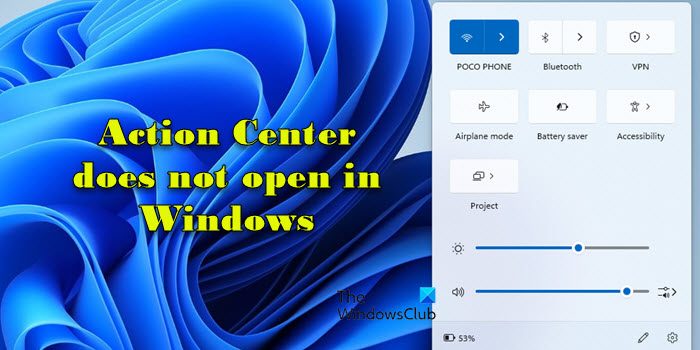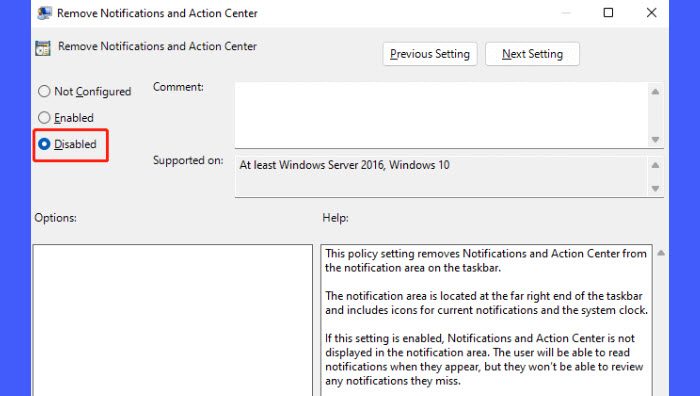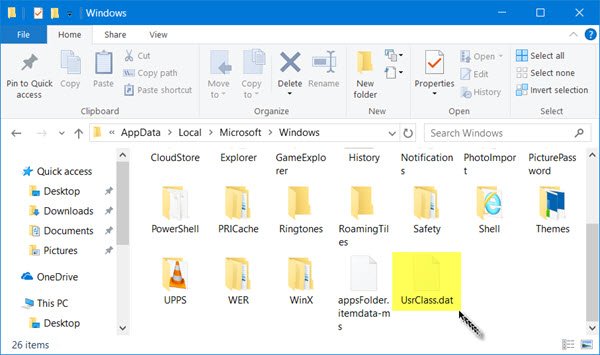If your Action Center does not open or is not responding or showing notifications in Windows 11/10, read this post to learn how to fix the issue. Action Center is a feature designed to centralize and manage notifications and quick settings in Windows. It provides easy access to commonly used settings and real-time notifications about apps and other senders on a device.

To use the Windows Action Center, you may click the Wi-Fi, Volume, or Battery icon given on the lower right side of the taskbar. Alternatively, you can use the keyboard shortcut Win+A to open the Windows Action Center panel. The feature gives you the ability to clear notifications and specify what type of notification you want to receive. You can then determine which notifications require attention and further examination by you and which ones are to be dismissed.
Action Center does not open on Windows 11/10
Sometimes you may find yourself face-to-face in a situation where your Action Center does not open or it might have stopped working. Now, you must be wondering what those situations can be. The following will help you determine whether the Action Center is working properly or not:
- If hovering the cursor on the Action Center icon on the taskbar, it shows new notifications, but on clicking on the same, no notifications can be found.
- If the Action Center continues to show the same notifications even after clearing them all.
- If the Action Center does not open upon clicking on its icon on the taskbar.
If you’re encountering any of these three problems, then it is a sign that you need to fix the Action Center of your device. The first step should be rebooting your system and checking if it works. If not, use the following fixes to resolve the issue:
- Check if the Action Center is enabled
- Restart File Explorer
- Re-register Action Center using PowerShell command
- Rename UsrClass.dat File
- Perform Clean Boot
Before you begin, create a system restore point first and ensure that your Windows 11/10 OS is updated.
Let us see the above solutions in detail.
1] Check if the Action Center is enabled

It is possible that the Action Center has been disabled in Registry or Group Policy settings if you’re not able to access it in Windows 11/10.
Press Win+R to open Run dialogue. Type ‘regedit’ and press Enter. Click Yes in the User Account Control prompt. Navigate to the following registry key:
HKEY_CURRENT_USER\Software\Policies\Microsoft\Windows\Explorer
Double-click on DisableNotificationCenter and verify that the Value data is ‘0’. If not, set it to ‘0’.
Next, open Run dialogue, type ‘gpedit.msc’ and press Enter.
In the Group Policy Editor window, navigate to User Configuration > Administrative Templates > Start Menu and Taskbar. Double-click on Remove notifications and Action Center on the right side and make sure the Disabled option is selected for the policy.
2] Restart File Explorer
If the Action Center won’t open, restart the File Explorer process and see if it helps. To do this, right-click the Start button icon and select Task Manager. Type ‘explorer’ in the Search bar on top.
Right-click Windows Explorer and select Restart.

Simply doing this has helped some users.
3] Re-register Action Center using PowerShell command

Open an elevated PowerShell prompt, type the following command, and press the Enter key:
Get-AppxPackage | % { Add-AppxPackage -DisableDevelopmentMode -Register "$($_.InstallLocation)\AppxManifest.xml" -verbose }
Once the process is completed, restart your computer and see if the issue is resolved.
4] Rename UsrClass.dat File

A post on Microsoft Answers recommends that you delete the UsrClass.dat file to fix the issue. UsrClass.dat is an important system file that contains the user class registry hive. This hive includes settings and preferences related to the Windows shell, such as file associations, desktop settings, and application-specific settings that apply to a specific user profile.
Press Win+R. The Run dialog box will open. Copy-paste the following in that box and click on OK:
%localappdata%\Microsoft\Windows
In the File Explorer window, scroll down and locate the UsrClass.dat file. Rename the file as UsrClassold.dat.
If you can’t see the file, select Show > Hidden items in the View dropdown menu.
Renaming the file, followed by a system reboot should cure the problem. See this post if you get a warning stating The action can’t be completed because the file is open in System.
5] Perform Clean Boot
Boot in a Clean Boot State and see if this problem persists. If it does, you may need to identify which process is interfering with its smooth functioning.
TIP: See this post if Windows Action Center is missing.
All the best!
How to enable Windows Action Center in Windows 11?
Action Center is enabled by default in Windows 11. It has been revamped as part of the new UI changes and split into two separate sections known as Quick Settings and Notification Center. Quick Settings is the area that provides quick access to commonly used settings, such as, Wi-Fi, Bluetooth, Brightness and Volume; whereas, Notification Center is the area that displays notifications from apps and other senders. Keyboard shortcuts to open Quick Settings and Notification Center in Windows 11 are Win+A and Win+N respectively.
Why can’t I open the Action Center?
There might be several reasons why you are unable to open and use the Action Center in Windows. It might not work correctly due to system file corruption or issues with File Explorer or your current user profile. There could be malware or third-party software that disrupt its functionality or it might have been inadvertently disabled on your system. Registry settings and Group Policy settings might also block access to the Action Center in Windows. These issues can typically be resolved following the steps mentioned in this post.
Read Next: How to Disable Notification Center in Windows 11.
Restart File Explorer worked for me, thanks